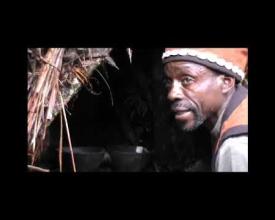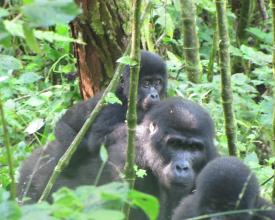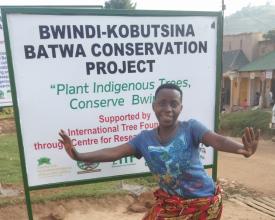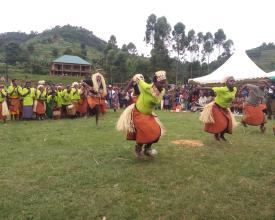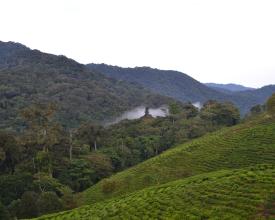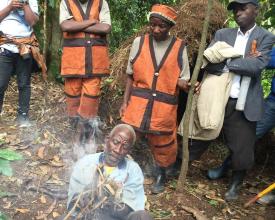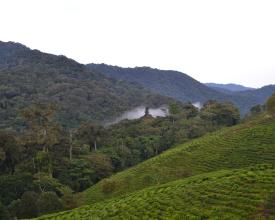
Integration of the Batwa cultural values to save world mountain gorillas at Bwindi using GAPA
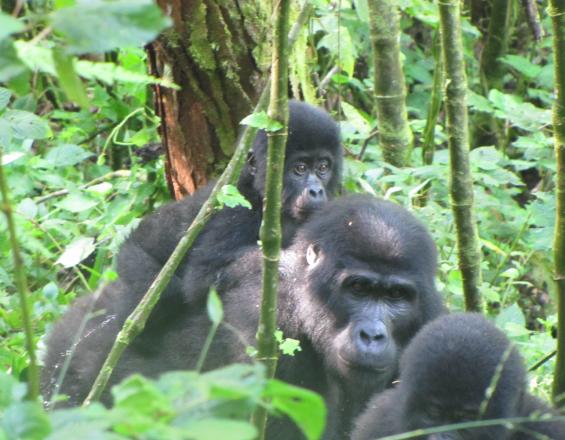
World mountain gorillas are threatened due to subsistence and commercial sources of livelihoods by the community. Before the gazettement of Bwindi in 1991, Batwa depended on Bwindi resources as their home which they lost after gazettement. As a result, they pose a threat to the most desired resources - medicinal plants and bush meat. Through a systematic assessment on governance and identification of priority actions, protected area managers have recognised the underlying governance complexities and identified a cultural values approach to achieve sustainable livelihoods of Batwa community and conservation of Bwindi. Because of the assessment, we have organised the Batwa plant indigenous trees in the community, based on their traditional values and indigenous knowledge to meet their subsistence needs and generate income through ecotourism and research. This is hoped to create a social fence against poaching and reduce pressure on Bwindi protected resources.
Context
Challenges addressed
Environmental challenges
Protected area managers had not understood the governance complexities at Bwindi Mgahinga Conservation Area (BMCA) which have led to poaching incidents resulting in biodiversity loss. One of the outstanding complexities has been failure to recognise the Batwa cultural values as a pathway to promote sustainable livelihoods and conservation.
Social and economic challenges
There has been limited attendance of park meetings and activities by Batwa and local communities. This is due to resentment by local communities caused by crop and livestock losses by wild animals. Furthermore, the Batwa indigenous people have limited options to livelihood sources due to the underprivileged position they have in society and the prejudice by other non-Batwa communities. This discrimination limits prioritisation of their forest linked livelihoods options.
Location
Process
Summary of the process
The governance assessment exercise (block 1) created a basis for the integrated action planning (block 2). The governance assessment used a multi stakeholder engagement process from the preparation stage to the action planning stage/taking action. The selection of actors was purposive as earlier identified in planning and preparation of the assessment. The action planning was participatory in nature and various stakeholders identified priority action areas and took responsibility for their shares in terms of implementation of the action areas. The integrated action planning involved grouping of actions as local actions and policy related actions. It is evident that the governance assessment results created a basis for priority actions. If action areas are implemented, the governance situation of Bwindi Mgahinga Conservation Area will improve and the governance assessment will therefore be meaningful.
Building Blocks
Governance assessment of the protected area
Before the governance assessment, we undertook a scoping exercise that involved all relevant stakeholders. The assessment used a multistakeholder and multistage engagement process for the scoping exercise, information gathering and validation of results. The scoping workshop informed key governance aspects that enabled the selection of critical governance principles assessed. Various governance issues were identified and how they relate to the conservation of Bwindi. Stakeholders were able to identify best alternative priority actions and how they work. Stakeholders were able to identify the integration of Batwa cultural values as a key feasible solution that can link indigenous people to conservation and their livelihoods. In the implementation of the cultural values approach, various stakeholders are being involved to measure its effectiveness.
Enabling factors
-
The support and willingness by Uganda Wildlife Authority as a protected area management body has been instrumental in facilitating this solution.
-
Recognition of the governance complexities as major conservation challenges by all actors such as Uganda Wildlife Authority, Local Government of Kisoro, Rubanda and Kanungu, local communities (including indigenous Batwa) and other conservation organizations
-
The funding from BIOPAMA was a strong evidence that using small resources effectively, we can achieve greater outputs and outcomes
Lesson learned
-
Identification of and addressing governance complexities has been appreciated by stakeholders as a pathway to sustainable conservation and livelihoods
-
Involvement of all relevant stakeholders is key in delivering tangible conservation and livelihood outcomes. It requires micro engagement of actors and how they agree to work together.
-
The current protected area management policies are rigid and require amendment to allow integration of governance aspects
Integrated action planning by stakeholders
Before the assessment, stakeholders were planning separately in their individual organizations. The assessment brought together Uganda Wildlife Authority, Centre for Research Uptake in Africa, Local Government of Kanungu, Rubanda and Kisoro and other key conservation organizations such as Bwindi Mgahinga Conservation Trust, International Gorilla Conservation Programme, United Batwa Organisation Development in Uganda, Bwindi Batwa Community Development Association and Uplift the Rural Poor to collectively come up with an integrated action plan and take responsibility for their actions and inactions. This had not taken place in a long period of time. After the integrated action plan, each actor was able to take up their share of actions.
Enabling factors
-
The desire to address conflicts between the protected area and local communities
-
The recognition of each stakeholders’ responsibilities and roles towards sustainable conservation and livelihoods
-
Actor’s commitment to address the duplication of service delivery at Bwindi Mgahinga Conservation Area
Lesson learned
-
Integrated planning by various actors leads to focused interventions and wider conservation and livelihood outcomes
-
Actors have a desire to work together but they lack collaboration, coordination and resources
-
Integrated planning using GAPA is a key aspect of accountability and ensures quick actions to underlying governance challenges
Impacts
There has been a great appreciation from stakeholders of the linkage between culture, nature and livelihoods. The assessment brought to light governance complexities which then also created accountability for all stakeholders. A new project focusing on planting indigenous trees was developed and funded by the International Tree Foundation where a community pocket forest buffer to Bwindi has been established. Linking the Batwa’s culture to nature conservation and livelihoods is reconnecting them to nature and reigniting their conservation values. Batwa are hoped to be anti-poaching scouts by providing a social fence to poaching incidents and this reduces pressure on Bwindi resources. Poaching has reduced from 60% to 30% and no Mutwa has been found poaching in the last 12 months. The Batwa have started making money through leading tourists and researchers on identification of indigenous trees, especially herbal medicine.
Beneficiaries
Batwa indigenous people- These are traditionally known as forest people who used to live in tropical forests
Non-Batwa local people- These include Bakiga and Bafumbira communities
Management and staff of Uganda Wildlife Authority
Sustainable Development Goals
Story
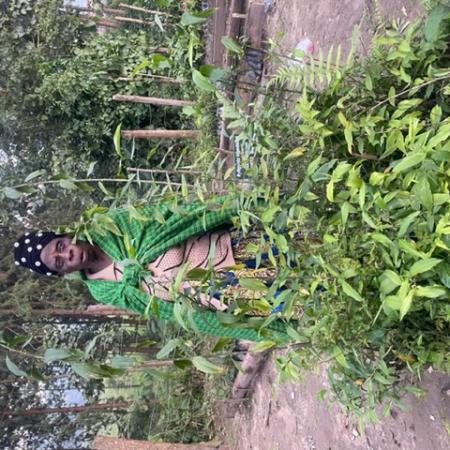
My name is Jovanisi Nyiragasigwa a Mutwa female elder. I am the Chairperson of the tree planting and resource committee. I lead other 12 Batwa that have consistently collected wildlings from the park and planted trees on community land. As the Batwa, we were neglected but thanks to Dr. Medard Twinamatsiko who led a governance assessment that resulted into the recognition of the cultural values and indigenous knowledge that we have as Batwa people who used to live in the forest. Medard has become like our father. The assessment brought key stakeholders together especially those that we earlier feared to engage as Batwa. The assessment brought hope that was lost and we can now see the benefits of conservation using our culture. The assessment meetings and workshops I attended have equipped me with new ways of thinking and working together, and I gained other interpersonal skills. After the recognition of our cultural values, Uganda Wildlife Authority has allowed us to collect wildlings and seedlings from the protected area to plant them on community land. Every time I go to Bwindi I reconnect with nature and appreciate the value of conservation. I always feel connected to my ancestors and our traditional elders. This helps me to reconnect with my natural world. I pass through our cultural sites such as places of worship, big trees and caves when collecting wildlings. This refreshes me to love conservation more and support UWA to conserve Bwindi. I believe that when our trees grow, we will get medicine and wild food which will be good for our health. All this would not have been possible if it was not the governance assessment exercise that we participated in.
